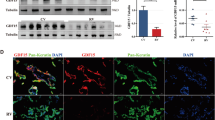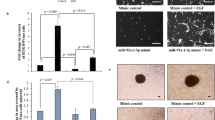Abstract
Objective
The objective of this study was to observe the effects of the overexpression of miR-3074-5p in human trophoblast cells in vitro.
Design
Experimental in vitro study in HTR8/SVneo cells.
Methods
HTR8/SVneo cells were transfected with miR-3074-5p mimic. The cell apoptosis and invasion were measured via flow cytometry and transwell assay, respectively. The expression levels of P53, Cyclin Dependent Kinase Inhibitor I B (P27), BCL-2, BCL2 associated X (BAX), and BCL2 like 14 (BCL-G) in HTR8/ SVneo cells were determined by Western blot. The alterations in gene expression profile of HTR8/SVneo cells were evaluated by complementary DNA microarray assay, and the differential expressions of dihydrolipoamide S-succinyltransferase (DLST), growth-associated protein 43 (GAP43), runt-related transcription factor 2 (RUNX2), and C-C type chemokine receptor 3 (CCR3) were validated by Western blot. Biofunctions of these differentially expressed genes were enriched by Gene Ontology analysis.
Results
The overexpression of miR-3074-5p in HTR8/SVneo cells promoted cell apoptosis but inhibited cell invasion, being accompanied by the significantly elevated expressions of P27, BCL-2, and BCL-G. Meanwhile, an increased expression of P27 and P57 was also detected in a small sample size of placental villi of recurrent miscarriage (RM) patients. Totally, 41 I genes and 397 genes were screened out, respectively, to be downregulated or upregulated at least by 2-folds in miR-3074-5p overexpressed HTR8/SVneo cells. These differentially expressed genes were involved in several important functions related to pregnancy. Subsequently, the reduced expressions of DLST and GAP43 proteins, as well as the increased expressions of CCR3 and RUNX2 proteins, were validated in miR-3074-5p overexpressed HTR8/SVneo cells. Conclusion: These data suggested a potential contribution of miR-3074-5p in the pathogenesis of RM by disturbing the normal activities of trophoblast cells.
Similar content being viewed by others
References
Brezina PR, Kutteh WH. Classic and cutting-edge strategies for the management of early pregnancy loss. Obstet Gynecol Clin North Am. 2014;41(1):1–18.
Rai R, Regan L. Recurrent miscarriage. Lancet. 2006;368(9535): 601–611.
Lunghi L, Ferretti ME, Medici S, et al. Control of human tropho-blast function. Reprod Biol Endocrinol. 2007;5(1):6.
Winship A, Correia J, Krishnan T, et al. Blocking endogenous leukemia inhibitory factor during placental development in mice leads to abnormal placentation and pregnancy loss. Sci Rep. 2015; 5(1):13237.
Wightman B, Ha I, Ruvkun G. Posttranscriptional regulation of the heterochronic gene lin-14 by lin-4 mediates temporal pattern formation in C. elegans. Cell. 1993;75(5):855–862.
Battel DP. MicroRNAs: genomics, biogenesis, mechanism, and function. Cell. 2004;116(2):281–297.
Harun R, Ruban L, Matin M, et al. Cytotrophoblast stem cell lines derived from human embryonic stem cells and their capacity to mimic invasive implantation events. Hum Reprod. 2006;21(6): 1349–1358.
Galliano D, Pellicer A. MicroRNA and implantation. Fertil Steril. 2014;101(6):1531–1544.
Hull ML, Nisenblat V. Tissue and circulating microRNA influence reproductive function in endometrial disease. Reprod Biomed Online. 2013;27(5):515–529.
Dong F, Zhang Y, Xia F, et al. Genome-wide miRNA profiling of villus and decidua of recurrent spontaneous abortion patients. Reproduction. 2014;148(1):33–41.
Qin W, Tang Y, Yang N, et al. Potential role of circulating micro-RNAs as a biomarker for unexplained recurrent spontaneous abortion. Fertil Steril. 2016;105(5):1247–1254 e1243.
Tang L, Gao C, Gao L, et al. Expression profile of micro-RNAs and functional annotation analysis of their targets in human chorionic villi from early recurrent miscarriage. Gene. 2016;576(1 pt 2):366–371.
Gu Y, Zhang X, Yang Q, et al. Aberrant placental villus expression of miR-486-3p and miR-3074-5p in recurrent miscarriage patients and uterine expression of these micrornas during early pregnancy in mice. Gynecol Obstet Invest. 2015;1(1):1.
Abou-Kheir W, Barrak J, Hadadeh O, et al. HTR-8/SVneo cell line contains a mixed population of cells. Placenta. 2017; 50(1):1–7.
Yang M, Chen Y, Chen L, et al. miR-15b-AG02 play a critical role in HTR8/SVneo invasion and in a model of angiogenesis defects related to inflammation. Placenta. 2016;41(1):62–73.
Ding GC, Chen M, Wang YX, et al. MicroRNA-128a-induced apoptosis in HTR-8/SVneo trophoblast cells contributes to preeclampsia. Biomed Pharmacother. 2016;81(1):63–70.
Graham CH, Hawley TS, Hawley RG, et al. Establishment and characterization of first trimester human trophoblast cells with extended lifespan. Exp Cell Res. 1993;206(2):204–211.
Salic A, Mitchison TJ. A chemical method for fast and sensitive detection of DNA synthesis in vivo. Proc Natl Acad Sci USA. 2008;105(7):2415–2420.
Szklarczyk D, Franceschini A, Wyder S, et al. STRING vlO: protein-protein interaction networks, integrated over the tree of life. Nucleic Acids Res. 2015;43(database issue):D447–D452.
Unek G, Ozmen A, Kipmen-Korgun D, et al. Immunolocalization of PCNA, Ki67, p27 and p57 in normal and dexamethasone-induced intrauterine growth restriction placental development in rat. Acta Histochemica. 2012;114(1):31–40.
Dior UP, Kogan L, Chill HH, et al. Emerging roles of microRNA in the embryo-endometrium cross talk. Semin Reprod Med. 2014; 32(5):402–409.
Ge YZ, Xu LW, Xu Z, et al. Expression profiles and clinical significance of MicroRNAs in papillary renal cell carcinoma: a STROBE-compliant observational study. Medicine. 2015;94(16): e767.
Korkmaz C, Sakinci M, Akyol SN, et al. Location of proliferating cell nuclear antigen and p53 protein in human first trimester and term placenta. Anal Quant Cytopathol Histpathol. 2013;35(6): 335–343.
Nadeem L, Brkic J, Chen YF, et al. Cytoplasmic mislocalization of p27 and CDK2 mediates the anti-migratory and antiproliferative effects of Nodal in human trophoblast cells. J Cell Sci. 2013;126(pt 2):445–453.
Gu Y, He Y, Zhang X, et al. Deficiency of monoclonal non-specific suppressor factor beta (MNSFB) promotes pregnancy loss in mice. Mol Reprod Dev. 2015;82(6):475–488.
Suzuki HI, Young RA, Sharp PA. Super-enhancer-mediated RNA processing revealed by integrative MicroRNA network analysis. Cell. 2017;168(6):1000–1014 el015.
Borriello A, Bencivenga D, Criscuolo M, et al. Targeting p27Kipl protein: its relevance in the therapy of human cancer. Expert Opin Ther Targets. 2011;15(6):677–693.
Podmirseg SR, Jakel H, Ranches GD, et al. Caspases uncouple p27(Kipl) from cell cycle regulated degradation and abolish its ability to stimulate cell migration and invasion. Oncogene. 2016; 35(35):4580–4590.
Wei P, Jin X, Zhang XS, et al. Expression of Bcl-2 and p53 at the fetal-maternal interface of rhesus monkey. Reprod Biol Endocrinol. 2005;3(1):4.
Gross A. BCL-2 family proteins as regulators of mitochondria metabolism. Biochim Biophys Acta. 2016;1857(8):1243–1246.
Bai Y, Wang J, Han J, et al. BCL2L10 inhibits growth and metastasis of hepatocellular carcinoma both in vitro and in vivo. Mol Carcinog. 2016;1(1):1.
Unek G, Ozmen A, Mendilcioglu I, et al. The expression of cell cycle related proteins PCNA, Ki67, p27 and p57 in normal and preeclamptic human placentas. Tissue & cell. 2014;46(3): 198–205.
Gundogan F, Elwood G, Mark P, et al. Ethanol-induced oxidative stress and mitochondrial dysfunction in rat placenta: relevance to pregnancy loss. Alcohol Clin Exp Res. 2010;34(3):415–423.
Wang JM, Gu Y, Zhang Y, et al. Deep-sequencing identification of differentially expressed miRNAs in decidua and villus of recurrent miscarriage patients. Arch Gynecol Obstet. 2016;293(5): 1125–1135.
Miled C, Pontoglio M, Garbay S, et al. A genomic map of p53 binding sites identifies novel p53 targets involved in an apoptotic network. Cancer Res. 2005;65(12):5096–5104.
Zhang YY, Li X, Qian SW, et al. Down-regulation of type I Runx2 mediated by dexamethasone is required for 3T3-L1 adi-pogenesis. Mol Endocrinol. 2012;26(5):798–808.
Henriquez B, Hepp M, Merino P, et al. C/EBPbeta binds the P1 promoter of the Runx2 gene and up-regulates Runx2 transcription in osteoblastic cells. J Cell Physiol. 2011;226(11):3043–3052.
Anderson NM, Li D, Peng HL, et al. The TCA cycle transferase DLST is important for MYC-mediated leukemogenesis. Leukemia. 2016;30(6): 1365–1374.
Diaz-Munoz MD, Bell SE, Fairfax K, et al. The RNA-binding protein HuR is essential for the B cell antibody response. Nat Immunol. 2015;16(4):415–425.
Zhang H, Wu F, Kong X, et al. Nerve growth factor improves functional recovery by inhibiting endoplasmic reticulum stress-induced neuronal apoptosis in rats with spinal cord injury. J Transl Med. 2014;12(1):130.
Luo Y, Shen H, Liu HS, et al. CART peptide induces neurore-generation in stroke rats. J Cereb Blood Flow Metab. 2013;33(2): 300–310.
Hannan NJ, Jones RL, White CA, et al. The chemokines, CX3CL1, CCL14, and CCL4, promote human trophoblast migration at the fetomaternal interface. Biol Reprod. 2006;74(5):896–904.
Athanassakis I, Papadimitriou L, Vassiliadis S. Murine ectopla-cental cone-derived trophoblast cells express chemokine receptors. J Reprod Immunol. 2001;50(2):105–119.
Chang MC, Tsai YL, Liou EJ, et al. Effect of butyrate on collagen expression, cell viability, cell cycle progression and related pro-teins expression of MG-63 osteoblastic cells. PloS one. 2016; 11(11):e0165438.
Author information
Authors and Affiliations
Corresponding authors
Rights and permissions
About this article
Cite this article
Gu, Y., Shi, Y., Yang, Q. et al. miR-3074-5p Promotes the Apoptosis but Inhibits the Invasiveness of Human Extravillous Trophoblast-Derived HTR8/SVneo Cells In Vitro. Reprod. Sci. 25, 690–699 (2018). https://doi.org/10.1177/1933719117725823
Published:
Issue Date:
DOI: https://doi.org/10.1177/1933719117725823




